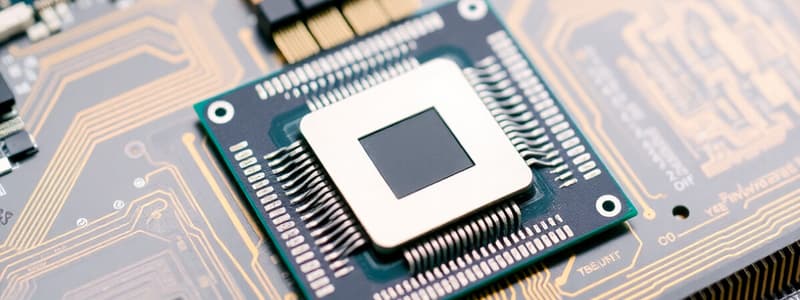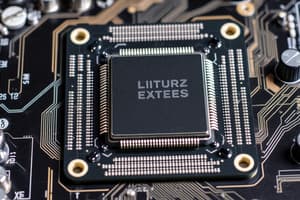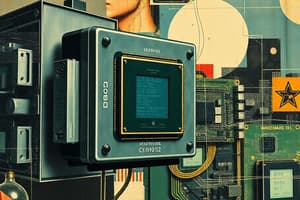Podcast
Questions and Answers
Which of the following is most important to consider when choosing a hardware device for an organization?
Which of the following is most important to consider when choosing a hardware device for an organization?
- The hardware's compatibility with the latest software.
- The hardware's aesthetic appeal within the office environment.
- The potential for later improvements to meet evolving organizational needs. (correct)
- The initial cost of the hardware.
What is the primary role of the Arithmetic Logic Unit (ALU) within a CPU?
What is the primary role of the Arithmetic Logic Unit (ALU) within a CPU?
- To temporarily store small units of program instructions.
- To access program instructions sequentially.
- To perform mathematical calculations and logical comparisons. (correct)
- To manage the flow of data between the CPU and memory.
Which unit of time is equivalent to one-trillionth of a second?
Which unit of time is equivalent to one-trillionth of a second?
- Microsecond
- Millisecond
- Nanosecond
- Picosecond (correct)
What unit is used to measure clock speed?
What unit is used to measure clock speed?
Which characteristic distinguishes secondary storage from main memory?
Which characteristic distinguishes secondary storage from main memory?
Which storage solution involves creating extra bits of data from existing data to allow reconstruction in case of failure?
Which storage solution involves creating extra bits of data from existing data to allow reconstruction in case of failure?
Which of the following is the proper sequence, from smallest to largest, when measuring computer storage capacity?
Which of the following is the proper sequence, from smallest to largest, when measuring computer storage capacity?
Which type of enterprise storage involves a dedicated, high-speed network providing direct connections between data-storage devices and computers?
Which type of enterprise storage involves a dedicated, high-speed network providing direct connections between data-storage devices and computers?
What is the initial step in getting data into a computer system from a human-readable source?
What is the initial step in getting data into a computer system from a human-readable source?
Which input device is capable of interpreting human speech?
Which input device is capable of interpreting human speech?
Which input device is commonly used to read the magnetic ink found at the bottom of bank checks?
Which input device is commonly used to read the magnetic ink found at the bottom of bank checks?
What technology does London's Oyster card use to enable public transport passengers to pay their fare?
What technology does London's Oyster card use to enable public transport passengers to pay their fare?
What is the key difference between OLED and LCD screens?
What is the key difference between OLED and LCD screens?
Which of the following is considered a specialized output device?
Which of the following is considered a specialized output device?
Which type of computer is designed for applications requiring extensive and rapid computational capabilities?
Which type of computer is designed for applications requiring extensive and rapid computational capabilities?
What aspect of computer systems does 'Green Computing' primarily address?
What aspect of computer systems does 'Green Computing' primarily address?
Which of the following is NOT a typical role of a server?
Which of the following is NOT a typical role of a server?
Which of the following BEST describes the function of the control unit within a CPU?
Which of the following BEST describes the function of the control unit within a CPU?
Considering the trend that 'the faster the clock speed, the more heat it generates', what is a significant implication for hardware design?
Considering the trend that 'the faster the clock speed, the more heat it generates', what is a significant implication for hardware design?
How does a 'Disc Mirror' contribute to data management and protection?
How does a 'Disc Mirror' contribute to data management and protection?
What factor primarily determines how quickly software can run on a computer?
What factor primarily determines how quickly software can run on a computer?
In the context of data input, what is the purpose of 'data entry'?
In the context of data input, what is the purpose of 'data entry'?
Which scanning device is commonly used in retail environments to capture image and character data at Point-of-Sale areas?
Which scanning device is commonly used in retail environments to capture image and character data at Point-of-Sale areas?
Considering handheld computers/smartphones are multi-function devices, what technical distinction classifies a device as a smartphone?
Considering handheld computers/smartphones are multi-function devices, what technical distinction classifies a device as a smartphone?
How does the role of Mainframe computers change in an organization that uses large information-processing and data-storage setups?
How does the role of Mainframe computers change in an organization that uses large information-processing and data-storage setups?
Considering the objectives of green computing, which practice aligns with its environmental goals?
Considering the objectives of green computing, which practice aligns with its environmental goals?
In terms of collaboration among employees, what benefit does using effective computer hardware provide?
In terms of collaboration among employees, what benefit does using effective computer hardware provide?
Why might an organization choose to invest in enterprise storage options like NAS or SAN over simple attached storage?
Why might an organization choose to invest in enterprise storage options like NAS or SAN over simple attached storage?
Which of these is a characteristic of primary storage that is crucial for a computer’s processing speed?
Which of these is a characteristic of primary storage that is crucial for a computer’s processing speed?
Flashcards
Computer Hardware Objectives
Computer Hardware Objectives
The objectives should support information systems and organizational needs.
Value of Knowing About Hardware
Value of Knowing About Hardware
Enhances productivity, revenue, customer service, and collaboration.
Computer Processing
Computer Processing
Processes input via CPU and primary storage.
Arithmetic/Logic Unit (ALU)
Arithmetic/Logic Unit (ALU)
Signup and view all the flashcards
Control Unit
Control Unit
Signup and view all the flashcards
Registers (CPU)
Registers (CPU)
Signup and view all the flashcards
Machine Cycle Time
Machine Cycle Time
Signup and view all the flashcards
MIPS
MIPS
Signup and view all the flashcards
Clock Speed
Clock Speed
Signup and view all the flashcards
Primary Storage
Primary Storage
Signup and view all the flashcards
Secondary Storage
Secondary Storage
Signup and view all the flashcards
Magnetic Tape
Magnetic Tape
Signup and view all the flashcards
Magnetic Disk
Magnetic Disk
Signup and view all the flashcards
SSD
SSD
Signup and view all the flashcards
Computer Storage Units
Computer Storage Units
Signup and view all the flashcards
Human-Readable Data
Human-Readable Data
Signup and view all the flashcards
Machine-Readable Data
Machine-Readable Data
Signup and view all the flashcards
Data Entry
Data Entry
Signup and view all the flashcards
Data Input
Data Input
Signup and view all the flashcards
Speech-Recognition Technology
Speech-Recognition Technology
Signup and view all the flashcards
MICR Devices
MICR Devices
Signup and view all the flashcards
Magnetic Stripe Card
Magnetic Stripe Card
Signup and view all the flashcards
Chip and Pin Cards
Chip and Pin Cards
Signup and view all the flashcards
Contactless Cards
Contactless Cards
Signup and view all the flashcards
Pen Input Devices
Pen Input Devices
Signup and view all the flashcards
Radio Frequency Identification
Radio Frequency Identification
Signup and view all the flashcards
Plasma Display Monitors
Plasma Display Monitors
Signup and view all the flashcards
LCDs
LCDs
Signup and view all the flashcards
Green Computing
Green Computing
Signup and view all the flashcards
Study Notes
Principles of Computer Hardware
- Assembling computer hardware requires understanding each device's role in supporting information systems and organizational needs.
- Computer hardware objectives are subordinate to, but supportive of, information systems and organizational needs.
- Hardware device choices should allow for later improvements.
Reasons to Learn About Hardware
- Hardware improves worker productivity and increases revenue.
- Cost are reduced through better customer service
- Speed-up-time-to-market can be achieved
- Collaboration is enabled among employees and business partners, like suppliers.
Hardware for Processing
- Each computer processes input through a processing unit and primary storage.
- Key components include CPU (Central Processing Unit), ALU (Arithmetic Logic Unit), Control Unit, and Registers
Central Processing Unit
- It is made up of three associated elements - the arithmetic/logic unit (ALU), control unit, and registers.
- ALU handles math calculations and makes logical comparisons.
- Control unit accesses program instructions, decodes them, and coordinates data flow in and out of the Arithmetic Logic Unit, registers, primary and secondary storage, and output devices.
- Registers are high-speed storage areas that temporarily hold the small units of program instructions and data used immediately before, during, and after the CPU executes them.
Processing and Memory Devices
- Machine Cycle Time is measured in nanoseconds (one-billionth of a second), or picoseconds (one trillionth of a second).
- Machine Cycle Time is measured by instructions executed; MIPS (Millions of Instructions per second).
- Clock Speed is measured in megahertz (millions of cycles per second) or gigahertz (billions of cycles per second).
- The faster the clock speed, the more heat generated.
Primary Storage
- Main memory provides the CPU with a working storage area for program instructions and data.
- The main feature of main memory is that it rapidly provides data and instructions to the CPU
- Main memory devices have circuits imprinted on a silicon chip, conducting electricity (on) or not (off), known as binary digits, or bits.
- Data is stored in memory as a combination of on or off circuit states; each character is represented by 8 bits.
Secondary Storage
- The amount of data companies store digitally increases at almost 100 percent yearly.
- Secondary storage, or permanent storage, allows the storing of large amounts of data and instructions more permanently than main memory.
- Compared with main memory, secondary storage offers non-volatility, greater capacity, and economy.
Secondary Storage Devices
- Magnetic tape is a sequential storage medium.
- Magnetic disk is a direct access storage device.
- RAID (redundant array of independent/inexpensive disks) is a method of storing data that generates extra bits.
- Disc Mirror stores data that provides an exact copy
- Virtual tape is used for less frequently accessed data.
- Optical discs uses special lasers to read and write data and provide digital versatile disc-DVD options.
- Holographic disc uses lasers to store computer-generated data in three dimensions and provide holographic storage.
- SSD (Solid State Secondary Storage Devices) stores data in memory chips.
- Memory cards includes flash memory.
- USB (Universal serial Bus) are used
- Computer storage units include Bytes(1), Kilobytes(1024), Megabytes(million), Gigabytes(billion), Terabytes(trillion), Petabytes(quadrillion), Exabytes(quintillion).
Enterprise Storage Options
- Attached storage is attached to a single computer.
- Network-attached storage is storage devices attaching to a network instead of one computer.
- Storage area network is similar to network-attached, except it is a dedicated, special-purpose, high-speed network providing direct connections between data-storage devices and computers across the enterprise.
- Enterprise Storage – NAS (Network-Attach Storage) consists of hard disk storage with its own network address.
Data Input
- Input transfers human-readable data, like a sales order, into the computer system.
- 'Human-readable' is the data that people can read and understand.
- Machine-readable data, like a bar code, can be understood and read by computer devices
- Getting data into the computer system is done in two stages:
- Converting human-readable data into a machine-readable form through data entry.
- Transferring the machine-readable data into the system is data input.
Input Devices
- Keyboards and mice are key input devices
- Speech-recognition technology enables a computer with a source of audio input such as a microphone to interpret human speech as a means of providing data or instructions to the computer.
- Digital cameras record and store images and video in digital form.
- Terminals are electronic or electromechanical hardware devices for entering and transcribing data into a computer system.
- Scanning devices capture image and character data; examples include photocopiers and handheld scanners at Point-of-Sale areas.
- Optical data readers consist of optical mark recognition (OMR), that used on a multiple choice exam to detect a mark on a page and optical character recognition (OCR) to 'read' handwritten or typed characters.
- Magnetic ink character recognition (MICR) devices are used to read 'magnetic ink' at the bottom of bank checks.
- A magnetic stripe card that has a credit card, ID card, or debit card allows input by swiping the card through a reader.
- Chip and pin cards use a computer chip that communicates with a card reader
- Contactless cards contain an embedded chip that only needs to be held close to a terminal.
- Point-of-Sale devices are terminals, such as a bar code reader, used to enter data into a computer.
- Automated teller machine (ATM) devices are special-purpose input/output devices that bank customers use to perform withdrawals and transactions with their bank accounts.
- Pen Input Devices input data by touching a screen with a pen input device, on a tablet PC.
- Touch-Sensitive Screens allow for input
- Radio Frequency Identification reader sends a radio signal that is picked up and returned by a tag, with the reader recognises and identifies the tag.
- Radio Frequency Identification uses a microchip with an antenna for broadcasting its unique identifier and location to receivers.
- London's Oyster card uses RFID technology to let public transport passengers pay their fare; a reader in the station takes payment off the built-in chip.
Output Devices
- Display monitors displays output from the computer like a TV screen.
- Plasma screens use thousands of smart cells (pixels), consisting of electronics, neon, and xenon gases, that are turned into plasma.
- Liquid Crystal Displays (LCDs) are flat displays that use liquid crystals to form characters and graphic images on a backlit screen.
- Organic Light-Emitting Diodes are used in small electronic devices; while LCD screens contain a fluorescent backlight, OLEDs directly emit light.
- Printers and plotters provide paper output.
- 3D Printers take a 3-dimensional model or object stored on a computer to create the object.
- Digital audio player store, organize, and play digital music files like an mp3 player, or iPod.
- Computer-based navigation systems are GPS systems becoming popular with drivers.
- Eyebud screens and 3D printers are specialized output devices.
- E-book readers are electronic books.
Computer System Types
- Handheld computer is also known as pocket PCs, or PDAs for extremely mobile and multi-function devices.
- Smart phone is a handheld computer that can make phone calls.
- Portable Computers include laptops and tablet PCs, audio devices, pagers, tablets, and netbooks.
- Thin Client is low cost, with limited capabilities and only performs essential applications, remaining 'thin' in client applications; it relies on a network connection and centralized server capacity (no extra drives, like CD or DVD).
- Thick Client can do processing at the local terminals.
- Smart Client can do complex processing across the network.
- Desktop PC is the traditional view of a computer.
- Workstation is more powerful than a desktop PC, but looks the same.
- Server is for many users to perform tasks, with large memory and storage capacities, and fast communications abilities; there include:
- Web server handles Internet traffic.
- Internet caching server stores web sites.
- Enterprise server stores and provides access to programs that meet an organization's needs.
- File server stores and coordinates program and data files.
- E-mail server sends and receives e-mails.
- Servers offer the scalability to increase the processing capability of a computer system or network to handle more users or transactions.
- Mainframe Computers are large, powerful computer shared by concurrent users connected through a network, typically kept in data centres with controlled temperature, humidity, and dust levels.
- Mainframe jobs are changing and large information-processing and data-storage roles have been expanded for organizations.
- Supercomputers are the most powerful computers with the fastest processing speed and performance, designed for applications needing extensive and rapid computation; they use specialized graphic processing unit chips which are efficient at manipulating computer graphics.
- Supercomputers perform floating point operations
Considerations when Selecting and Upgrading Computer Systems
- Hard drive considerations should be the capacity, speed, and media capabilities needed.
- Main memory considerations should be more RAM to run software faster.
- Printer considerations should be based on major considerations like price, color, and speed.
- Environmental issues must also be considered when selecting and upgrading.
- Green Computing considers the environment when designing, manufacturing and operating computers.
Summary of Hardware
- Hardware is the machinery that assists in the input, processing, storage, and output activities of an information system.
- Hardware components include: central processing unit (CPU), input/output devices, communications devices, primary storage, and secondary storage devices.
- Secondary storage devices: e.g. magnetic tapes and disks, DVDs, and memory cards.
- Enterprise storage options consist of attached storage, network-attached storage (NAS), and storage area network (SAN).
- Examples of input devices are: keyboards, mice, voice-recognition devices, terminals, scanning devices, and touch-sensitive screens.
- Examples of output devices are: display monitors, liquid crystal displays (LCDs), printers, and plotters.
- Computers can be classified as either special-purpose or general purpose.
- Computer system types are: handheld, portable, desktop, workstations, and servers.
Studying That Suits You
Use AI to generate personalized quizzes and flashcards to suit your learning preferences.




